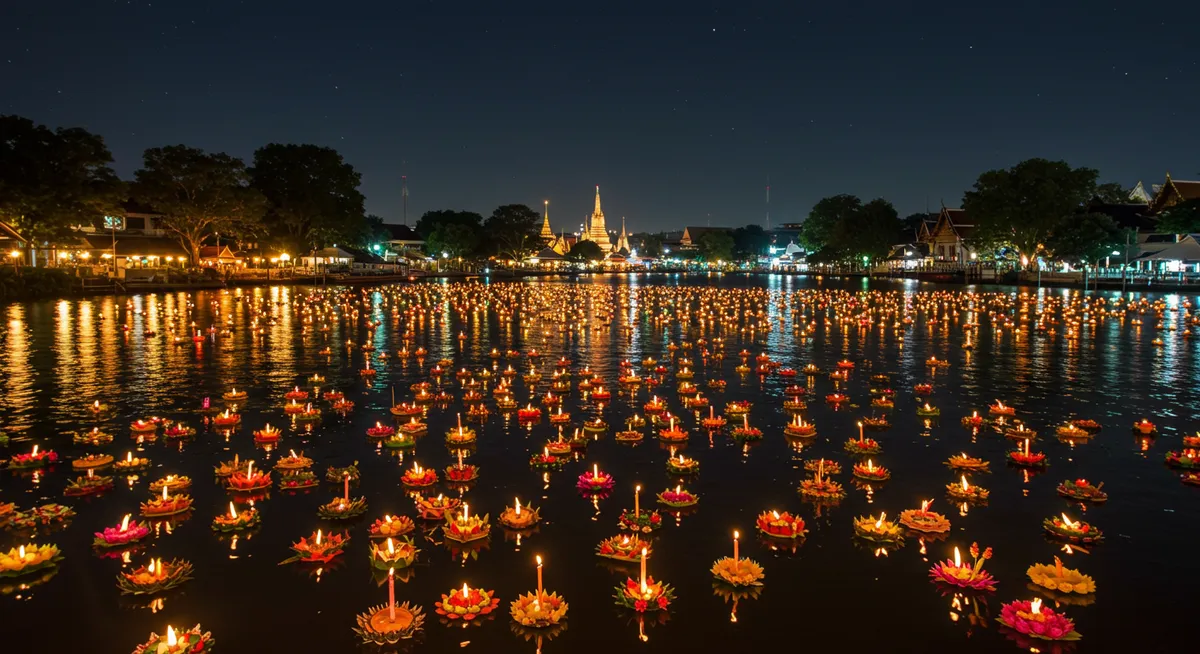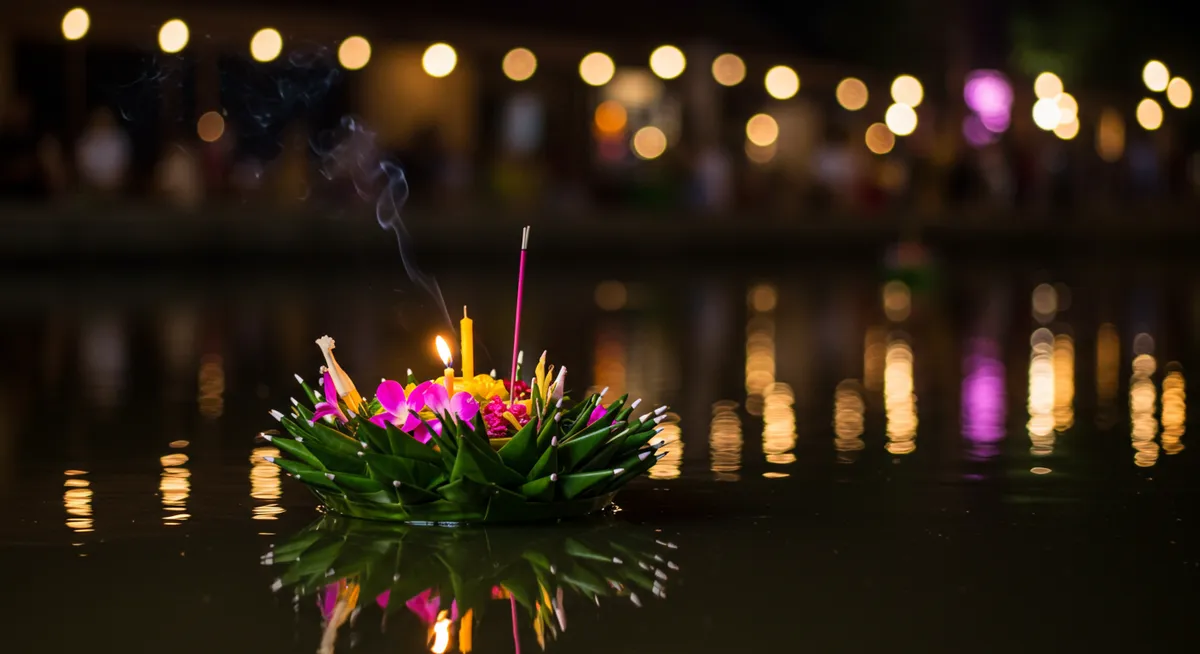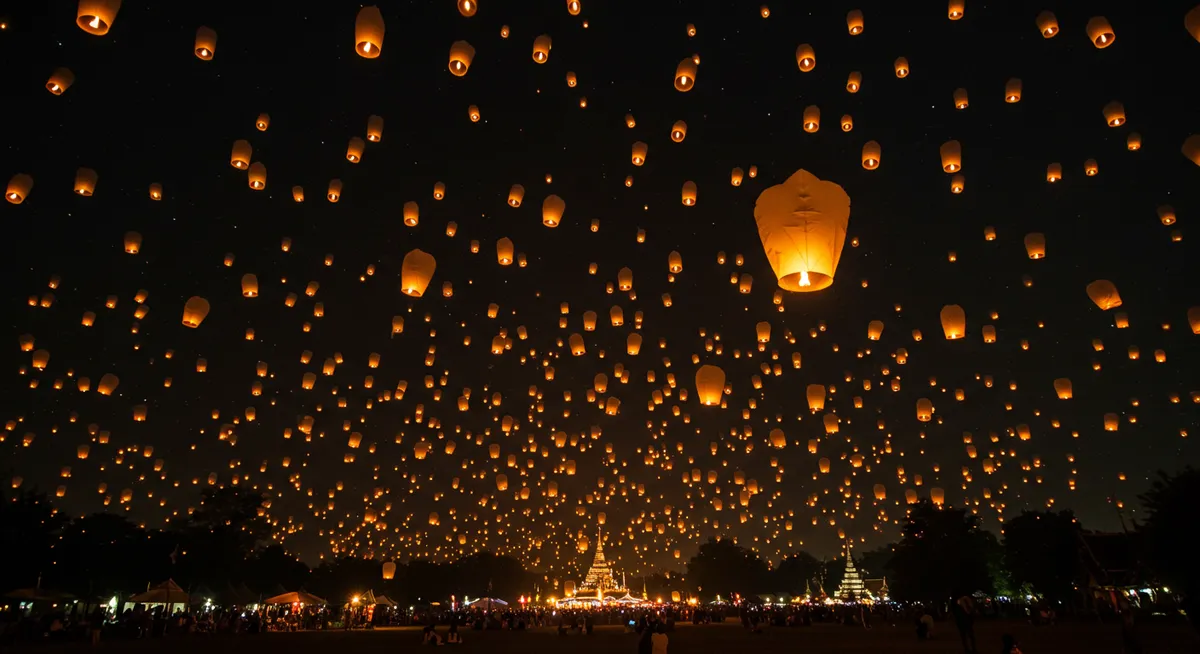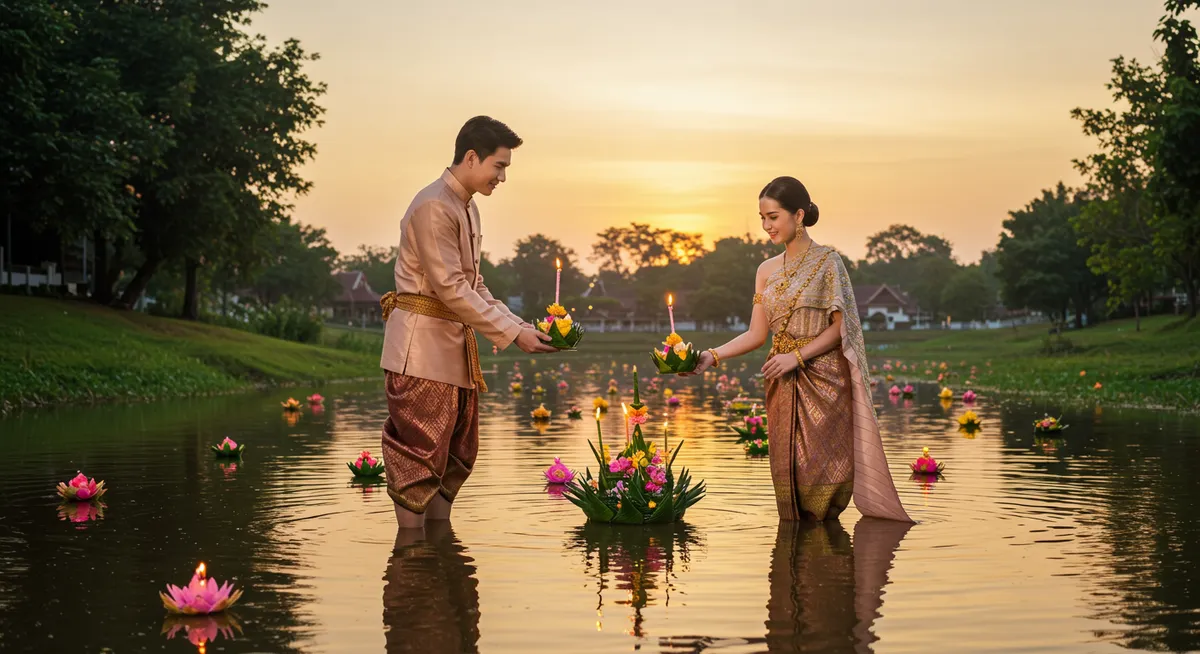Loy Krathong Festival Guide | Thailand's Enchanting Celebration of Lights on Water

Loy Krathong: Thailand's Enchanting Festival of Lights on Water
On the evening of the full moon in the twelfth lunar month, Thailand transforms into a realm of ethereal beauty as thousands of candlelit offerings drift along rivers, lakes, and waterways across the kingdom. Loy Krathong, often translated as "floating basket festival," represents one of Southeast Asia's most visually captivating celebrations—a night when Thais gather along shorelines to release delicate vessels made of banana leaves, flowers, candles, and incense onto the water's surface. These illuminated krathongs carry away negativity while honoring the water goddess and creating an unforgettable tableau of lights dancing on gentle currents. This guide explores the cultural significance, regional variations, and magical atmosphere of Thailand's most picturesque festival that has captivated both locals and visitors for centuries.

The Cultural and Spiritual Significance
Loy Krathong embodies several layers of cultural and spiritual meaning:
- Water Goddess Veneration: Paying respects to Phra Mae Khongkha, the goddess of water
- Spiritual Cleansing: Symbolic release of negativity, misfortune, and transgressions
- Buddhist Influence: Offering gratitude for the use of water and seeking forgiveness for pollution
- Brahmanical Roots: Connection to ancient Indian traditions honoring river deities
- Natural Cycles: Celebration of the end of the rainy season and peak rice harvesting period
Historical Origins
The festival's origins blend multiple historical influences:
- Sukhothai Kingdom: Traditional accounts trace formal celebrations to the ancient Thai capital (13th-14th centuries)
- Nang Nopphamat Legend: Story of a court lady who created the first decorative krathong to please King Ramkhamhaeng
- Brahmanical Influence: Adaptation of Indian Deepavali or floating lamp traditions
- Agricultural Foundations: Connection to ancient rice farming rituals and water thanksgiving ceremonies
- Buddhist Integration: Incorporation of Buddhist merit-making and spiritual cleansing concepts
The Art of Krathong Making
Creating the festival's signature floating offerings involves traditional craftsmanship:
- Natural Materials: Traditionally made from banana trunk slices or banana leaves folded into lotus shapes
- Floral Decorations: Intricate arrangements of marigolds, orchids, and other local flowers
- Essential Elements: Each krathong includes a candle (light), incense sticks (fragrance), and often a small coin (offering)
- Personal Touches: Many people add nail clippings or strands of hair to symbolize letting go of part of oneself
- Eco-Friendly Evolution: Growing use of biodegradable materials like bread or natural starch replacing styrofoam bases

Regional Variations and Unique Expressions
Loy Krathong takes distinctive forms across different regions of Thailand:
Sukhothai: The Historical Heartland
The ancient capital celebrates with particular grandeur:
- Historical Park Setting: Celebrations amid the illuminated ruins of the 13th-century capital
- Light and Sound Performances: Elaborate shows depicting the festival's legendary origins
- Nang Nopphamat Beauty Contests: Competitions honoring the festival's legendary creator
- Traditional Longboat Illuminations: Distinctive boat processions through historical waterways
- Sukhothai-Style Krathongs: Especially elaborate designs following historical patterns
Chiang Mai: Yi Peng and the Sky Lanterns
Northern Thailand's celebration combines water and sky illumination:
- Yi Peng Tradition: Release of sky lanterns (khom loi) coinciding with Loy Krathong
- Mass Lantern Releases: Spectacular coordinated launches creating rivers of light in the sky
- Lanna Cultural Elements: Northern Thai music, dance, and ceremonial aspects
- Elaborate Parades: Distinctive processions featuring giant illuminated lanterns
- Temple-Centered Activities: Special religious ceremonies at major temples like Wat Phra Singh
Bangkok: Urban Grandeur
The capital creates spectacular metropolitan celebrations:
- Riverside Spectacles: Major events along the Chao Phraya River, especially at Asiatique complex
- Royal Presence: Traditional royal participation at Wat Arun and other significant locations
- Illuminated Landmarks: Special lighting of temples and historic sites across the city
- Modern Entertainment: Contemporary concerts and performances integrated with traditional elements
- International Atmosphere: Significant tourist participation creating a multicultural celebration

Tak: The Thousand Coconut Shell Lanterns
A unique western Thai variation:
- Coconut Shell Krathongs: Distinctive use of hollowed coconut shells instead of banana leaves
- River Illumination: Thousands of floating coconut lanterns on the Ping River
- Traditional Border Culture: Incorporation of elements from nearby Myanmar (Burma)
- Loi Krathong Sai: Special tradition of launching lines of connected floating lanterns
- Mountainous Backdrop: Uniquely scenic setting with mountains reflecting in the illuminated water
Southern Thailand: Extended Celebrations
The southern provinces feature distinctive customs:
- Three-Day Format: Longer celebration period in many southern communities
- Ceremonial Theater: Traditional shadow puppet performances (nang talung) incorporated into festivities
- Islamic Influences: In Muslim communities, adaptations that respect Islamic traditions
- Coastal Celebrations: Unique seaside ceremonies in beach communities
- Southern Delicacies: Distinctive regional foods featured in festival markets
Festival Activities and Traditions
Beyond floating krathongs, the festival features various activities:
Beauty Pageants and Cultural Performances
Celebratory performances showcase Thai culture:
- Nopphamat Queen Contests: Traditional beauty pageants honoring the legendary creator of krathongs
- Traditional Dance: Performances of ram wong and other classical Thai dances
- Folk Music: Regional musical traditions featured in evening performances
- Cultural Demonstrations: Showcases of traditional crafts and cultural practices
- Theatrical Performances: Historical reenactments and traditional storytelling
Festive Foods and Market Culture
Special culinary traditions emerge during the festival:
- Seasonal Specialties: Traditional foods associated with the harvest season
- Riverside Food Stalls: Night markets featuring local delicacies along waterways
- Krathong-Shaped Desserts: Sweet treats mimicking the lotus shape of krathongs
- Communal Dining: Shared meals among family and community members
- Festival Drinks: Special beverages prepared for the celebration
Romantic Traditions
The festival holds special significance for couples:
- Couple Krathongs: Tradition of romantic partners floating offerings together
- Fortune Telling: Observing how krathongs float to predict relationship futures
- Wish Making: Couples making shared wishes while releasing their krathong
- Love Songs: Traditional love-themed music performed during festivities
- Marriage Proposals: Popular occasion for romantic commitments
Experiencing Loy Krathong as a Visitor
For travelers, the festival offers extraordinary experiences:
Best Locations for Visitors
Some venues provide particularly memorable festivities:
- Sukhothai Historical Park: The festival's spiritual home with celebrations amid ancient ruins
- Chiang Mai's Ping River: Combined Yi Peng and Loy Krathong celebrations creating dual illumination
- Bangkok's Asiatique: Accessible urban celebration with extensive facilities
- Ayutthaya Historical Park: Floating offerings amid the ruins of the ancient capital
- Hua Hin Beach: Unique seaside celebration in this royal resort town
Participation Guidelines
Respectful participation enhances the experience:
- Environmental Awareness: Choose biodegradable krathongs and follow local guidelines
- Cultural Respect: Understand the spiritual significance behind the beautiful visuals
- Dress Appropriately: Modest attire is appreciated, especially at temple-based events
- Photography Etiquette: Respect ceremonial moments and personal space when capturing images
- Safety Considerations: Exercise caution around waterways and with flame-based celebrations

The Evolution of Loy Krathong
The festival continues to adapt while maintaining its essence:
Environmental Considerations
Modern celebrations increasingly address ecological concerns:
- Biodegradable Materials: Promotion of bread-based and natural krathongs
- Clean-Up Initiatives: Organized recovery of krathongs from waterways
- Educational Campaigns: Raising awareness about water conservation alongside celebration
- Ecological Alternatives: Virtual krathongs and light projections as supplementary options
- Sky Lantern Regulations: Growing restrictions on mass lantern releases in some areas
Tourism Impact
International interest has influenced the festival:
- Expanded Events: Longer celebration periods and additional activities in tourist centers
- Community-Based Tourism: Local initiatives sharing authentic celebrations with visitors
- Special Photography Settings: Designated areas for capturing the visual spectacle
- English-Language Resources: Increased information accessibility for international visitors
- Cultural Exchange: Integration of visitors into traditional aspects of the festival
Contemporary Expressions
Modern Thailand brings new dimensions to ancient traditions:
- Digital Elements: Light shows, projections, and technology-enhanced celebrations
- Urban Adaptations: Creative expressions in areas without natural waterways
- Social Media Influence: Growing importance of Instagram-worthy settings and experiences
- Corporate Sponsorship: Major events supported by brands and businesses
- Global Thai Diaspora: Festival celebrations spreading worldwide through Thai communities
Planning your Loy Krathong experience?
Loy Krathong falls on the evening of the full moon in the 12th lunar month, typically in November. Check the exact date for your visit year, as it varies annually based on the lunar calendar.
For the most complete experience, consider visiting Chiang Mai to witness both the floating krathongs and Yi Peng sky lanterns, or Sukhothai for celebrations in the festival's historical birthplace. Book accommodations several months in advance, as this is one of Thailand's peak tourism periods.
Explore Related Asian Light Festivals
If you're enchanted by Loy Krathong, discover these other magnificent light celebrations across Asia:
Diwali
India's festival of lights with oil lamps, fireworks, and celebrations of light's triumph over darkness.
Tazaungdaing
Myanmar's festival of lights with hot air balloons and illuminated pagodas.
Mid-Autumn Festival
East Asian celebration with lanterns, mooncakes, and lunar appreciation.
Vesak
Buddhist celebration with candle processions and lantern ceremonies honoring Buddha.
Hoi An Lantern Festival
Vietnam's magical monthly celebration with hundreds of colorful lanterns along ancient streets.
Galungan
Balinese celebration when ancestor spirits visit earth, marked by decorated bamboo poles.
Across Asia, light festivals transform darkness into beauty through different traditions. While Loy Krathong creates rivers of light on water, Diwali illuminates homes with oil lamps, and Mid-Autumn Festival brightens nights with colorful lanterns. Each tradition expresses cultural identity while sharing universal themes of hope and renewal.